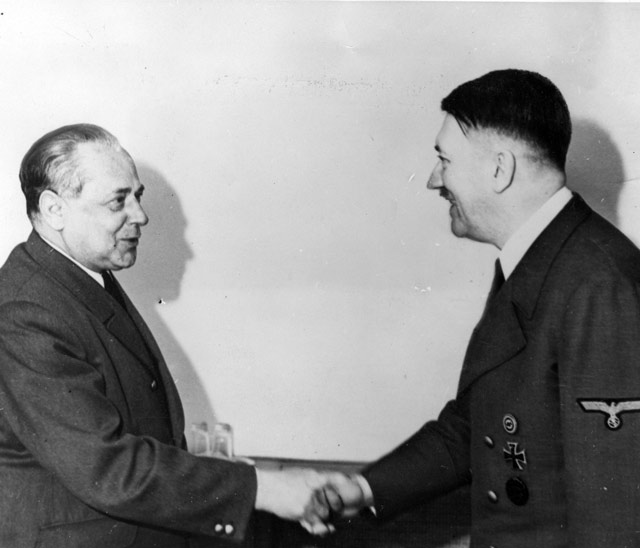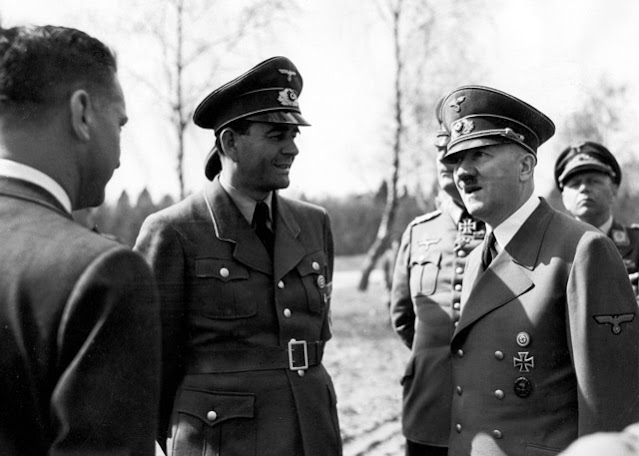Monday 20 April 1942
 |
| A military parade in honor of Adolf Hitler's birthday organized by Reichskommissar Koch in Rovno, Ukraine on 20 April 1942 (Federal Archive B 162 pic-04246). |
Battle of the Pacific: The Japanese high command is still furious on 20 April 1942 about the Doolittle raid and orders the massive Second Fleet, recently returned from its Indian Ocean Raid, to hunt down the American carrier task force. Nobody has any idea where the US ships are, and Admiral Nagumo aboard his own carrier, the Akagi, thinks they may be within striking distance of his ships near Formosa and attack them. The fact that the US Navy used land-based bombers in the attack further confuses the Japanese. Meanwhile, USS Enterprise and Hornet have long since departed the scene as they return to Pearl Harbor. The US high command, mirroring Japanese concerns, also remains deeply worried about a Japanese attack on the west coast.
In the Philippines, Japanese artillery continues to pound the last US island outpost of Corregidor. The Japanese have overrun US positions on Cebu and Panay, and US and affiliated Filipino garrisons throughout the northern and central Philippines have fled into the hills to operate as guerilla forces on Leyte, Samar, Negros, and Bohol.
Soviet freighter Turksib is wrecked in bad weather in the Unimak Strait, Alaska Territory. The USSR and Japan are not at war, so Soviet ships may pass more-or-less freely between their home ports and the United States, though they are subject to search for military goods by Japanese patrol vessels.
 |
| Reich Foreign Minister Joachim Ribbentrop congratulates Adolf Hitler on his 53rd birthday, 20 April 1942 (Source: National Digital Archives, Poland). |
Battle of the Indian Ocean: Chinese General Sun Li-Jen, having successfully rescued trapped British forces on the 19th, continues attacking south toward the Yenaungyaung oil fields. The small Chinese force makes some progress and inflicts heavy casualties on the Japanese, but this success is only temporary and the Chinese soon begin retreating back to the north. The British 1st Burma Division that barely had escaped destruction due to the Chinese advance finds vehicles to take it north to Mount Popa.
Eastern Front: The spring thaw ("Rasputitsa") is rapidly increasing, causing extensive flooding and muddy conditions that make operations difficult. General Franz Halder notes in his war diary:
Curiously quiet. Enemy is seemingly anticipating a German red-letter day attack. Enemy propaganda. Good progress on the Lovat River. The gap has been almost closed. Consolidation of the situation on the Volkhov River.
The two operations that Halder mentions, on the Lovat and Vokhov rivers, are of utmost importance to both sides as large numbers of troops are at risk. The former is the relief operation to rescue the huge German forces trapped at Demyansk and Kholm, and the latter is a large Soviet force including the Second Shock Army that is trapped west of the Volkhov. While the outcome of both operations has been in doubt for months, the Germans gradually are gaining the upper hand in both sectors.
The Soviet Stavka (high command) officially ends the Rzhevsk-Vyazma Operation and orders forces in the area over to the defensive. This follows a partially successful breakout of trapped Soviet forces in the area east of Smolensk. The operation was a failure in its objective to encircle and destroy large Wehrmacht forces, but the Soviets claim that it succeeded in forced German forces back 100-250 kilometers.
European Air Operations: There are no operations today due to some very thick ground haze. A circus over a French port is briefly planned but scrubbed at 12:15 local time.
 |
| Time magazine features German Admiral Karl Raeder on its cover on 20 April 1942 (Cover Credit: BORIS ARTZYBASHEFF). |
Battle of the Atlantic: U-572 (Kptlt. Heinz Hirsacker), on its fourth patrol out of Brest, torpedoes, and sinks 7164-ton British freighter Empire Dryden about 240 nautical miles (440 km) northwest of Bermuda. There are 25 deaths and 22 survivors, who are picked up by the US freighter City of Birmingham.
U-752 (Kptlt. Karl-Ernst Schroeter), on its fifth patrol out of La Pallice, torpedoes, shells, and badly damages US freighter West Imboden about 200 miles off the Nantucket lightship. The freighter was an easy target due to an accidental fire in its stack that gave away its position. The U-boat captain has a conversation with the survivors in their lifeboats and says "That's good" when told there have been no casualties. West Imboden later sinks.
U-654 (Oblt. Ludwig Forster), on its third patrol out of Brest, torpedoes and sinks 4569-ton Swedish freighter Agra about 280 nautical miles (520 km) northwest of Bermuda. There are six deaths and 33 survivors, who are picked up by Norwegian freighter Tercero. Torpedoing neutral shipping obviously is improper, but all ships are transiting in blackout conditions and it is largely impossible to tell neutral shipping from legitimate targets.
U-654 also torpedoes and sinks 6176-ton US freighter Steel Maker about 350 nautical miles (650 km) east of Wilmington, North Carolina. There are one death and 47 survivors, who are rescued by British freighter Pacific Exporter and USS Rowan. The one crewman rescued by the Rowan is in the water until 18 May 1942.
U-109 (Kptlt. Heinrich Bleichrodt), on its fifth patrol out of Lorient, torpedoes and sinks 5719-ton British freighter Harpagon about 150 nautical miles (280 km) northwest of Bermuda. There are 41 deaths and eight survivors, who are picked up by Argentinian freighter Rio Diamante.
 |
| Adolf Hitler and his personal photographer, Heinrich Hoffmann, on 20 April 1942. |
U-154 (KrvKpt. Walther Kölle), on its second patrol out of Lorient, torpedoes and sinks 5587-ton Canadian freighter Vineland in the mid-Atlantic. There are 34 survivors and one death.
Royal Navy submarine HMS Trident torpedoes and sinks 5386-ton German freighter Hödur northwest of Namsos, Norway.
Royal Navy destroyers Cotswold and Quorn, operating as escorts for Convoy FS 80 in the North Sea, hit mines off Aldeburgh, Suffolk. Quorn (two deaths) is towed by patrol sloop Shearwater to Chatham and requires 17 weeks of repairs, while Cotswold (five dead, 23 wounded) is towed Shotley Spit and beached. Refloated later, Cotswold re-enters service on 8 May 1943.
British 1498-ton freighter Plawsworth and Belgian 1829-ton freighter Vae Victis, members of Convoy FS 80, also hit mines and sink in the North Sea off Aldeburgh, Suffolk.
Swedish 569-ton coaster Arete hits a mine and sinks in the Danish Great Belt strait. There are four deaths.
German 470-ton trawler/minesweeper M 4006 Neuwerk hits a mine and sinks in the English Channel off Morlaix, Finistère, France.
 |
| General Walther Buhle, Chief of Organizations Section, OKH, congratulates Adolf Hitler for his 53rd birthday, 20 April 1942 (Source: National Digital Archives, Poland). |
Battle of the Mediterranean: Aircraft carrier USS Wasp (CV-7) flies off 48 Spitfire fighters of RAF No. 601 and 603 Squadrons to land in Malta, which has had no operational fighter cover recently. The Wasp's Grumman F4F Wildcats provide air cover. Operation Calendar has resulted from a personal request from Winston Churchill to President Roosevelt for the use of a US carrier for this purpose.
The Luftwaffe has been alerted to the joint US-British operation and times an air raid to coincide with the landing of the Spitfires at Malta's Ta'Qali airfield. The RAF fighters, low on fuel after their shuttle flight, cannot defend themselves and must land immediately, leaving them vulnerable. The German bombers, facing no air opposition, destroy most of the incoming fighters immediately and virtually all of them within days (some sources say within two days, others within four days).
The British military command and Churchill are aghast at this disaster. They set in motion plans to replace the island's longtime governor, Lieutenant General Sir William Dobbie, who blames the failure on the intense bombardment that the island has faced over the past month from German General Albert Kesselring's continuing air offensive.
Battle of the Black Sea: Soviet icebreaker Ledokol No. 7 hits a mine laid by the Luftwaffe and sinks between Novorossiysk and Kerch. There are 25 dead and 11 survivors.
 |
| Turkish Ambassador to the Reich Hüsrev Gerede signs the list congratulating Adolf Hitler on his birthday in the Reich Chancellery on 20 April 1942 (Schwahn, Federal Archive Image 183-J01196). |
Partisans: The Italian and German security services in eastern Bosnia under the overall command of General der Artillerie Paul Bader begin Operation Trio. The operation targets all insurgents between Sarajevo and Drina. Bader gives the Italians military control over civil affairs in the areas of operation, a key Italian goal for expanding their zone of control in the Balkans despite their continuing difficulties with the partisans. The first phase of Operation Trio, an advance east toward the Drina, begins today, but this is a massive operation using regular army troops as well as auxiliaries that is intended to last for throughout the spring. Italian, German, Croatian, and Chetnik forces take part.
The 718th Infantry Division advances from Sarajevo, Olovo, and Tuzla. The initial goal is to relieve an embattled Croatian garrison at Rogatica in an area swarming with partisans in the surrounding countryside. The Axis forces advance without much difficulty, but the effort is hampered by intra-Axis hostilities between the royalist Chetniks and the Ustaše Black Legion led by Jure Francetić.
In Rennes, France, the French Resistance makes an unsuccessful attempt to assassinate French fascist Jacques Doriot. He is a founder of the Légion des Volontaires Français (LVF), a French unit of the Wehrmacht. Doriot has fought in the Soviet Union as part of Operation Barbarossa and is highly esteemed by the Germans. Separately, German security troops in Rouen shoot 30 hostages in reprisal for an attack on a German troop train.
 |
| Adolf Hitler accepts congratulations on his birthday, 20 April 1942 (Source: National Digital Archive, Poland). |
German Military: At lunch with Hitler and other top generals, Reichsfuhrer SS Heinrich Himmler broaches the idea of using SS troops extensively on the Eastern Front in regular military formations. This has been done very sparingly so far, usually only in emergency situations, as the SS is considered more of a "special operations" force. General Franz Halder notes in his diary that he takes "sharp issue" with this idea, perhaps realizing that this would introduce an entirely separate military command outside of the normal Wehrmacht chain of command. This would reduce both Halder's own control of operations and introduce problems in coordinating attacks.
US Military: US Army Air Force Major General George H. Brett assumes command of all Allied Air Forces in Australia and nearby areas. This includes units in Port Moresby, New Guinea.
 |
| The Berlin Philharmonic puts on a concert for Hitler's birthday, 20 April 1942. He is not in attendance, as he remains at his Fuhrer Headquarters in East Prussia. |
German Homefront: It is Adolf Hitler's birthday, always marked during the Third Reich with celebrations and speeches. Today's celebration is relatively low-key, and Hitler's main event is having lunch at Fuhrer Headquarters in Rastenburg with his top generals such as Halder and Himmler. New French leader (under figurehead Petain) Pierre Laval lavishes praise on Hitler ("He is a conqueror who did not abuse his victory") and characterizes the war as an attack on "Bolshevism."
Holocaust: Fritz Sauckel, the Reich Plenipotentiary General for Labor Mobilization, sends a memo to Alfred Rosenberg, Reich Minister for the Occupied Eastern Territories, about forced labor. It details a program of abduction and enslavement, focused mainly on Rosenberg's sphere of authority in Eastern Europe. Approximately 5 million men and women will be forced to work for the Reich as slave labor under this program. The document states that the program is necessary "for the armament of the Armed Forces and also for the nutrition of the Homeland" and " to the profit of Germany and her allies."
American Homefront: The San Francisco News reports that "The Army today ordered two more Los Angeles areas cleared of 2000 Japanese by noon of April 29." General De Witt also announces that the army is building a new "reception center" for internees at Tula Lake. All internees are urged to deposit large sums of money and valuables for safekeeping before going to the camps, as there will be no banks or other repositories there. The Army also announces that evacuations will "proceed at a rapid rate from now on."
 |
| The 20 April 1942 Life magazine features a cover story about women's slacks. |
April 1942
April 1, 1942: Convoys Come to the USAApril 2, 1942: Doolittle Raiders Leave Port
April 3, 1942: Japanese Attack in Bataan
April 4, 1942: Luftwaffe Attacks Kronstadt
April 5, 1942: Japanese Easter Sunday Raid on Ceylon
April 6, 1942: Japanese Devastation In Bay of Bengal
April 7, 1942: Valletta, Malta, Destroyed
April 8, 1942: US Bataan Defenses Collapse
April 9, 1942: US Defeat in Bataan
April 10, 1942: The Bataan Death March
April 11, 1942: The Sea War Heats Up
April 12, 1942: Essen Raids Conclude Dismally
April 13, 1942: Convoy QP-10 Destruction
April 14, 1942: Demyansk Breakout Attempt
April 15, 1942: Sobibor Extermination Camp Opens
April 16, 1942: Oil Field Ablaze in Burma
April 17, 1942: The Disastrous Augsburg Raid
April 18, 1942: The Doolittle Raid bombs Japan
April 19, 1942: British in Burma Escape
April 20, 1942: The Operation Calendar Disaster
April 21, 1942: Germans Relieve Demyansk
No comments:
Post a Comment